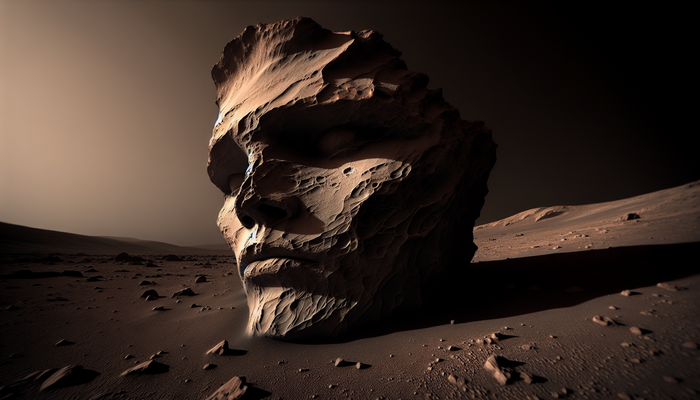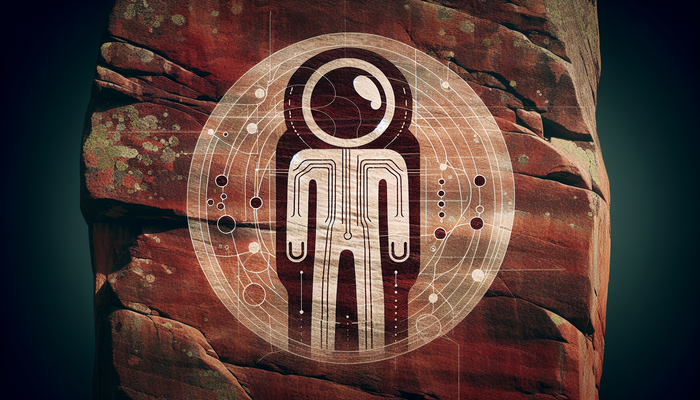Seeking Ancient Alien Outposts

By Howard Callahan, Ufologist
What if the most baffling structures and enduring myths of our past aren't just clever human engineering or fanciful folklore? What if they are echoes, faint but persistent, of something… not from around here? It’s a question that sits uneasily in the back of the mind when confronted with the sheer audacity of certain ancient achievements. This isn't just about fleeting lights in the sky, mind you. We're talking about the provocative idea of Ancient Alien Outposts – the notion that extraterrestrial beings might have not only visited Earth millennia ago but actually set up shop, establishing bases, strategic holdfasts, or hidden enclaves right here on our planet. Imagine, not just tourists, but long-term residents from beyond the stars.
This line of thinking is often bundled under the umbrella of the "Ancient Astronaut Hypothesis," a theory popularized by writers like Erich von Däniken and brought into countless living rooms by shows like HISTORY's Ancient Aliens, often featuring the enthusiastic Giorgio Tsoukalos. The core idea? That visitors from other worlds interacted with early humans, perhaps jump-starting our technology, shaping our cultures, maybe even tinkering with our biology. It’s a narrative that feeds on the undeniable fact that vast stretches of our own history remain frustratingly obscure. When faced with megalithic marvels that seem to defy the tools and techniques we think our ancestors possessed, or legends that speak of sky-gods delivering knowledge, the ancient alien outpost theory offers a tantalizing, albeit controversial, explanation.
Think about it: colossal stone structures erected with astonishing precision, artifacts made of materials seemingly ahead of their time, myths from disconnected cultures sharing uncanny similarities about beings descending from the heavens. These aren't just isolated oddities; they form a global pattern of anomalies that fuels the speculation. Were these sites merely the pinnacle of human achievement, or could they be signposts pointing towards a hidden chapter in our history, one involving established extraterrestrial footholds? This exploration isn't about definitive proof – that, my friends, remains elusive. Instead, we'll look into the intriguing locations, the puzzling artifacts, and the compelling questions that keep the search for ancient alien outposts alive, pushing the boundaries of accepted history and venturing into the realm of the truly unexplained.
Earth's Enigmatic Imprints: Where Ancient Structures Whisper of Otherworldly Visitors
The most visible breadcrumbs on the trail towards potential ancient alien outposts are quite literally set in stone. Scattered across the globe are monumental structures, built by civilizations long gone, that seem to mock the limitations we often ascribe to the past. The central argument, the hook upon which much of the ancient alien theory hangs, is one of "impossible engineering." Could ancient peoples, with only rudimentary tools and brute force, truly have quarried, transported, and assembled multi-ton blocks with such mathematical and astronomical precision? Proponents argue that the sheer scale and sophistication of some sites suggest an external helping hand – perhaps guidance, perhaps technology, provided by visitors who weren't native to this planet.
The Marvels of Giza, Egypt
Let's start with the big one, the poster child for ancient mysteries: The Great Pyramid and its neighbors stand as silent, imposing questions on the landscape. Forget the romantic image of simple ramps and rollers; consider the logistics. We're talking about millions of limestone and granite blocks, many weighing around two tons (that’s 4,000 pounds, folks!), moved and lifted to incredible heights. Ancient astronaut theorists point to the near-impossible accuracy – the sides aligned almost perfectly to the cardinal directions, with deviations of mere centimeters over hundreds of feet. How was this achieved in an era supposedly without compasses or advanced surveying equipment? The alignment of the three main pyramids with the stars of Orion's Belt is another frequently cited point, suggesting a sophisticated astronomical knowledge. But perhaps the most head-scratching claim, one that really makes you pause, is the alleged correlation between the Great Pyramid's geographical coordinates (29.9792458° N latitude) and the speed of light (299,792,458 meters per second). Coincidence? Or a deliberate, mind-boggling signature left by beings who understood the fundamental constants of the universe, perhaps even capable of time travel? Adding fuel to the fire is the curious lack of detailed construction records from the meticulous Egyptians themselves. While mainstream archaeology offers plausible explanations involving vast labor forces, ingenious ramp systems, and keen celestial observation, the sheer confluence of mathematical, engineering, and astronomical precision at Giza keeps the door open for more exotic interpretations.
Baalbek, Lebanon
Then there's Baalbek, Lebanon. Beneath the impressive Roman ruins lies a foundation staggeringly older, featuring some of the largest worked stones on the planet. The Trilithon consists of three massive limestone blocks, each estimated to weigh around 800 tons. Nearby lies the "Stone of the Pregnant Woman," an even larger single block weighing an estimated 1,200 tons, left unfinished in its quarry. How were these behemoths moved and positioned with such accuracy? The site itself was named after the Canaanite sky god Baal. The theory? This wasn't just a temple complex; it was built upon, or perhaps as, a colossal landing platform for the "gods" – interpreted, of course, as extraterrestrial visitors arriving and departing from Earth. The original purpose remains debated, but the scale of those foundation stones is hard to ignore.
Easter Island (Rapa Nui)
Journey across the world to the remote Pacific, and you'll find Easter Island (Rapa Nui) and its iconic Moai statues. Nearly 900 of these monolithic figures, averaging 13 feet tall and weighing 14 tons, dot the landscape. For years, they were known as just heads, until excavations revealed they have complete bodies buried beneath the surface, often covered in intricate petroglyphs. The mystery intensifies when you consider the island's isolation and the perceived limitations of the Rapa Nui people. Could they have carved, transported, and erected these giants using only stone tools and manpower? Erich von Däniken proposed that marooned aliens sculpted the originals with lasers. Shows like Ancient Aliens often feature suggestions that the Moai "walked" to their positions using extraterrestrial levitation technology. While archaeologists present compelling evidence for how the statues could have been moved using clever rope techniques and coordinated human effort, the sheer scale of the undertaking in such an isolated "outpost" of the Polynesian world continues to spark wonder and alternative theories.
Stonehenge, England
Back in Europe, Stonehenge, England, stands as a prehistoric enigma. This ring of massive sarsen stones and smaller bluestones, transported from miles away, aligns perfectly with the sunrise on the summer solstice and the sunset on the winter solstice. Its purpose – calendar, temple, burial ground – remains uncertain. Was it simply an incredible feat of Neolithic engineering and astronomical observation? Or, as some suggest, could it have served a more otherworldly function? Given that many of the stones contain quartz, a crystal known for its ability to hold frequency and energy (we use it in radios and computers today!), could Stonehenge and similar stone circles scattered across the British Isles have acted as beacons, perhaps utilizing Earth's own electromagnetic energies to signal or communicate with extraterrestrial visitors? Reports linking these ancient sites to sightings of mysterious lights or UFOs only add to this line of speculation.
Other Perplexing Sites
The list goes on, a global network of perplexing sites:
- Göbekli Tepe, Türkiye: Predating Stonehenge by 6,000 years, these intricate carved pillars and enclosures were built by hunter-gatherers, challenging the narrative that complex society and religion only arose after agriculture. Its purpose is a profound mystery. Could it represent an early interaction point, a place where ancient humans were influenced or guided?
- Nan Madol, Micronesia: An entire city built on over 100 artificial islets atop a coral reef, using an estimated 250 million tons of prismatic basalt logs, some weighing up to 50 tons. Local legends speak of the stones being flown into place by magic or by two brothers aided by a "giant bird" – interpreted by some as misunderstood alien technology or craft.
- Carnac Stones, France: Over 3,000 megalithic stones arranged in precise rows stretching for miles, forming geometric patterns like Pythagorean triangles that wouldn't have been mathematically understood for millennia. Were these patterns, only fully visible from the air, meant as messages or guides for beings arriving from above?
- Japanese Megaliths (Ishino-Hoden / Masuda no Iwafune): Massive, intricately carved single stones weighing hundreds of tons. Legends connect them to deities descending in "heavenly rock ships." Are these structures attempts to replicate or commemorate the vehicles of ancient alien visitors?
- Copan, Honduras: A major Mayan city where the alignment suggests "as above, so below," building the celestial realm on Earth. Intricately carved stelae and, most intriguingly, a stucco figure found in an underground temple that bears a striking resemblance to a modern astronaut wearing a helmet and possibly a regulator.
- Terracotta Army, China: While perhaps more a testament to human ambition, the sheer scale (8,000 life-sized, unique soldiers) and the unopened tomb of the First Qin Emperor continue to inspire awe and questions about the resources and dedication involved.
- Sardinia and Delphi: Sites hinting at mysteries through statues of giants with strange features (Sardinia) or architectural similarities to other potentially alien-influenced sites and stories of divine communication (Delphi).
These sites, spread across continents and millennia, form the bedrock of the ancient alien outpost theory. Their existence, their scale, their precision, and the myths surrounding them collectively raise the question: Were our ancestors entirely alone in their monumental endeavors?
Hidden Enclaves and Subterranean Secrets: Seeking Outposts Off the Beaten Path
While monumental structures under the open sky capture the imagination, the search for ancient alien outposts often leads to the planet's most remote and inaccessible corners. If you were an extraterrestrial visitor wanting to establish a long-term presence without attracting too much attention, where would you go? The vast, frozen wastes of Antarctica, the deep, crushing pressures of the ocean floor, or the concealing heights and depths of remote mountain ranges seem like prime real estate. These locations offer natural camouflage, isolation, and environments so extreme they naturally deter casual human exploration.
Antarctica
Antarctica, the frozen continent, is a recurring hotspot in these theories. Its sheer remoteness and the immense ice sheet covering its secrets make it a plausible candidate for a hidden base. Whispers of anomalous energy signals detected deep beneath the ice, or rumors of colossal, hidden caverns fuel speculation. One compelling, though fictional, YouTube narrative imagines researchers stumbling upon such an outpost – complete with intricate carvings, advanced artifacts, a crystalline tree-like power source projecting cosmic histories, and even surviving android refugees from an ancient interstellar war. This story, while imaginative, taps into the real theories swirling around the continent. Adding a layer of intrigue are claims related to declassified CIA documents allegedly referencing "Project Stargate" and mentioning an alien underground base somewhere in the unforgiving Antarctic landscape.
Alaska: Mount Denali and Mount Hayes
Travel north to the rugged wilderness of Alaska, and specifically Mount Denali (formerly Mt. McKinley) and nearby Mount Hayes. This region is reportedly rife with anomalous activity – strange lights, cryptid sightings, and frequent UFO reports. The most startling claim centers on the alleged detection of a massive, pyramidal structure buried beneath Mount Denali, dubbed the "Dark Pyramid." Said to be twice the size of Giza's Great Pyramid and made of black stone, lying hidden beneath the surface. The stories surrounding it are wild, including an alleged account from an electronic engineer who supposedly ventured inside and measured an energy output capable of powering all of Canada. Could such a structure be an ancient alien power plant or a camouflaged operations center, hidden deep within the mountain?
Mount Shasta, California
Further south, Mount Shasta in Northern California stands as another peak shrouded in mystery. For centuries, it’s been associated with strange disappearances, paranormal events, and persistent UFO sightings. Local indigenous tribes hold legends of "sky beings" descending upon the mountain, considering it sacred ground. Modern accounts speak of encounters with mysterious figures emerging from deep caves and lava tubes riddling the mountain's slopes. Adding a scientific wrinkle is the presence of a significant negative magnetic anomaly surrounding Shasta. Could this anomaly be natural, or could it, as some propose, be indicative of a hidden technology, perhaps even a portal or gateway used by entities traveling between dimensions or from off-world locations? Is Shasta a hidden base, or something even stranger – a doorway?
The Italian Alps
Across the Atlantic, the Italian Alps, particularly peaks like Mount Musiné and Mount Pirchiriano, have their own share of UFO lore and speculation about hidden bases. Historical sightings, including a notable 2018 incident where Italian Air Force F16s reportedly chased a large, luminous orb near Mount Musiné, keep the possibility alive. Here, the speculation extends to the idea of alien "embassies" – suggesting not just hidden bases, but locations for potential ongoing contact or diplomatic interaction, implying a more established and perhaps even complex relationship with humanity.
Underwater Mysteries
Even beneath the waves, mysteries persist. Remote lakes in China are cited as UFO hotspots, leading to theories of submerged extraterrestrial monitoring stations. While concrete evidence is scarce, the idea of underwater bases is compelling. If we were to find such a place, what might it look like? While purely fictional, descriptions from sources like the Barotrauma game wiki offer a conceptual glimpse: vast, water-filled complexes built with robust, unfamiliar materials, perhaps scaled for non-human inhabitants. Imagine exploring corridors filled with strange devices pulsing with unknown energies, alien terminals requiring cryptic artifacts to operate, defensive traps like gravity spheres or electrified walls, and perhaps even encountering remnants of the original builders or guardians. Discoveries might include perplexing artifacts or caches of rare materials unknown on Earth. This visualization helps frame what researchers might be looking for in the deep, unexplored parts of our world.
The very nature of these alleged hidden outposts makes verifying their existence incredibly difficult. Antarctica's ice, the ocean's depths, and the forbidding interiors of mountains guard their secrets well. This inherent elusiveness means that while the theories are intriguing, definitive proof remains just beyond our grasp, keeping these locations lodged firmly in the realm of speculation and mystery.
Beyond Earth's Surface: Could Our Celestial Neighbors Be Alien Outposts?
The search for ancient alien outposts isn't confined solely to the hidden corners of our own planet. Logically, if advanced extraterrestrials were operating in our vicinity, establishing bases beyond Earth would offer significant strategic advantages – a clear vantage point for observation, a convenient staging ground for terrestrial activities, and a location potentially less vulnerable than one on Earth's surface.
The Moon
And where better, proponents ask, than our closest celestial neighbor, the Moon? For decades, the Moon was seen as a geologically dead, silent world. But anomalies persist. The most cited is the phenomenon observed during the Apollo missions: when spent lunar modules or rocket stages impacted the Moon's surface, seismic instruments left by the astronauts registered that the Moon "rang like a bell" or a gong, reverberating for surprisingly long periods – over an hour for Apollo 12, and more than three hours after a heavier impact during Apollo 13, shaking to a depth of over 20 miles.
This unexpected reverberation led to a startling, highly controversial theory: could the Moon be hollow? Renowned scientist Carl Sagan, in his 1966 book Intelligent Life in the Universe, argued that a natural satellite cannot be hollow. Yet, the seismic data puzzled scientists. If the Moon were solid rock, especially lightweight basalt common on its surface which absorbs impact well, such prolonged vibrations wouldn't be expected. This scientific puzzle paved the way for a far more radical ancient astronaut hypothesis: What if the Moon isn't natural at all? What if it's an artificial structure?
The theory posits that the Moon could be a gigantic, hollow spaceship, deliberately placed in orbit around Earth countless eons ago. Its purpose? To serve as the ultimate observation post and forward operating base for extraterrestrial visitors. Imagine a celestial command center, perfectly positioned to monitor life developing on Earth, facilitating travel to and from our planet and perhaps other parts of the solar system. While mainstream science maintains the Moon is a natural satellite, formed billions of years ago likely from debris after a massive impact with Earth, and explains the vibrations through its specific geological composition and lower gravity, the "hollow moon" theory persists in ancient alien circles as perhaps the grandest "outpost" of all, hiding in plain sight right above our heads.
Artifacts, Texts, and Anomalies: Tangible Clues and Narrative Interpretations
Beyond speculating about hidden locations, the case for ancient alien outposts often relies on interpreting tangible objects and ancient narratives through an extraterrestrial lens. The argument pivots towards physical clues left behind – artifacts that seem technologically impossible for their time – and ancient stories that, when stripped of mythological dressings, might describe encounters with advanced beings and their technology.
Out-of-Place Artifacts (OOPArts)
Chief among these are "Out-of-Place Artifacts" (OOPArts): objects discovered in archaeological contexts that appear too advanced for the civilization that supposedly created them. Consider the Orichalcum ingots found in a 2,600-year-old shipwreck off Sicily. Analysis revealed an alloy primarily of copper and zinc, with traces of other metals. The problem? Extracting zinc metal from its natural ore requires processes thought to be unknown centuries before this ship sailed. This complex alloy remarkably matches descriptions of orichalcum, the legendary metal said to adorn the Temple of Poseidon on the lost continent of Atlantis. According to Plato, this metal, perhaps originating "from the heavens," was associated with the gods (Poseidon, Cadmus). Could these ingots be physical proof linking Atlantis, advanced metallurgy, and potentially extraterrestrial knowledge given to a lost civilization?
Then there's King Tut's Dagger. Found nestled among the treasures in the young pharaoh's tomb, this iron dagger baffled Egyptologists because it dated to centuries before Egypt's Iron Age. Recent analysis confirmed the blade is indeed iron, but not just any iron – it was forged from a meteorite. Working meteoric iron, with its high nickel content, is incredibly difficult even today, requiring high temperatures and advanced techniques to avoid brittleness. Yet, this ancient dagger is impeccably crafted, smooth, and sharp, almost looking cast. How did ancient Egyptian artisans achieve this? Proponents connect this to Egyptian myths like the Benben stone, a sacred object, possibly meteoric iron, said to have descended from the sky "like a firebird," sometimes depicted with figures emerging from it – interpreted as a representation of an alien landing craft. Perhaps the "gods" (ETs) shared metallurgical secrets, explaining this extraordinary artifact.
Perhaps even more perplexing is the Wedge of Aiud. Unearthed in Romania in the 1970s alongside wooly mammoth bones, suggesting immense age (potentially over 40,000 years), this object is primarily composed of aluminum alloy. However, humans only developed the technology to produce aluminum in industrial quantities in the 19th century. The wedge also possesses a thick layer of oxidation (patina), which scientists agree takes hundreds, if not thousands, of years to form naturally, corroborating its apparent antiquity. Hidden from public view for decades, its purpose remains unknown. Theories range from it being a component of an advanced, unknown terrestrial tool to, more speculatively, a piece of landing gear from a vertical takeoff and landing (VTOL) craft – possibly an extraterrestrial one that crashed long ago.
Even recent discoveries like natural quasicrystals found within a Russian meteorite fuel speculation. These unique atomic structures violate previously understood rules of crystallography and have properties potentially useful for advanced technologies. With rumors (albeit unverified) circulating that similar materials were found at the Roswell crash site and might possess anti-gravity properties when electrified, some wonder if these meteorites are nature's accident, or perhaps deliberate "seeds" or "gifts" intended to nudge human technological evolution forward.
Ancient Narratives and Myths
Ancient narratives provide another fertile ground for interpretation. Myths and religious texts worldwide are re-examined, not as allegories, but as potential historical records of alien encounters. The Mahabharata and Ramayana, ancient Hindu epics, are prime examples. They vividly describe wars between gods fought with flying vehicles (Vimanas) and weapons of incredible power – voice-activated missiles, weapons that multiply to hit multiple targets, stealth craft, nerve agents, and the devastating Brahmastra, capable of incinerating vast areas, often compared to a nuclear blast. Are these poetic exaggerations, or eyewitness accounts of battles between technologically advanced extraterrestrial factions?
Legends of Greek Fire, the infamous Byzantine weapon that burned fiercely even on water and whose formula remains lost, are linked to accounts of it being a gift from an "angel" to Emperor Constantine – easily reinterpreted as an alien technology transfer. Similarly, legendary swords like Amakuni's katana in Japan (impossibly sharp and strong, forged after prayers to the Kami) or King Arthur's Excalibur (shining with intense light, received from a mystical source) are viewed not just as magical items, but potentially as misunderstood pieces of advanced technology – perhaps laser-based weapons or blades secured by biometric locks ("The Sword in the Stone"). Myths about gods teaching humanity metallurgy – Hephaestus in Greece, Brigit among the Celts, Kanayago in Japan – are seen as further evidence of this knowledge transfer.
Even creation myths, like the Sumerian Atra-Hasis, which depicts gods creating humans as laborers, are interpreted literally. The idea arises that humans might be genetically engineered hybrids, containing a "divine spark" or soul trapped within a physical form crafted by alien beings, possibly explaining the dualistic nature often explored in philosophy and religion (like the Cathar belief in angels trapped in flesh). Stories like Pandora's Box, where evils are unleashed upon the world from a container, could be seen as accounts of negative extraterrestrial entities being deliberately introduced to Earth, perhaps through portals or gateways.
Finally, the rich oral traditions of indigenous peoples across the globe, speaking of sky-beings, ancestors from the stars, and transformative encounters, are increasingly considered potential repositories of genuine historical memories of extraterrestrial contact, passed down through generations before written records became common. Interpreting these diverse threads – artifacts that seemingly defy their timelines and texts reimagined as historical reports – forms a crucial part of the argument for ancient alien influence and the potential existence of their terrestrial outposts.
A Cosmic Conflict on Earth? Alignments, Energy, and Ongoing Mysteries
Beyond ancient ruins and puzzling artifacts, the search for alien outposts ventures into even more speculative territory, exploring the possibility of ongoing extraterrestrial presence, subtle energy signatures, and even ancient conflicts continuing into the modern era. If outposts existed, or still exist, might they leave traces beyond stone and metal?
Unusual Energy Signatures and Anomalies
Consider the recurring theme of unusual energy signatures and anomalies. The mysterious energy signal detected deep beneath the Antarctic ice, the staggering power output alleged to emanate from Alaska's "Dark Pyramid," and the strong negative magnetic anomaly surrounding Mount Shasta – could these be natural geological quirks, or evidence of advanced, perhaps non-terrestrial, power sources or technologies associated with hidden bases? Some theories even propose that Earth's own Van Allen radiation belts might not be entirely natural. Given their effectiveness in shielding the planet from deadly cosmic radiation, and observations suggesting they can change and morph, could they be part of an ancient, artificial defense system, perhaps designed by benevolent extraterrestrials to protect Earth from solar flares, cosmic rays, or even hostile alien weaponry like particle beams?
UFO Sightings and Military Interest
The persistent phenomenon of UFO sightings adds another layer. Reports aren't just confined to history; they continue today, often concentrated around specific locations ("hotspots") that sometimes overlap with areas suspected of housing ancient outposts, like Mount Shasta or the Italian Alps. Particularly intriguing are sightings reported over sensitive military installations, especially nuclear facilities in the US, UK, Iran, and elsewhere. Why would unidentified craft show such interest in our most powerful weapons? Theories abound: are they monitoring our destructive capabilities, concerned we might annihilate ourselves (and potentially the planet they also inhabit or value)? Are they intervening, as suggested by accounts like the 1967 Malmstrom Air Force Base incident where UFOs allegedly deactivated nuclear missiles? Or do they view our nuclear arsenal as a potential threat to them, perhaps the only terrestrial technology capable of challenging their dominance? The claims of whistleblowers like former Canadian Defense Minister Paul Hellyer, alleging multiple alien species visiting Earth with different, sometimes conflicting agendas, or the alleged discovery of files referencing "Non-Terrestrial Officers" and secret US space fleets by hacker Gary McKinnon, further muddy the waters, suggesting a complex, perhaps even conflict-ridden, interaction hidden from public view.
Ancient Alien Wars and Competing Factions
This leads to one of the most dramatic interpretations: the theory of ancient alien wars and competing factions. Drawing heavily on texts like the Mahabharata, proponents suggest that the "wars of the gods" were literal conflicts between extraterrestrial groups fought in Earth's skies and on its surface thousands of years ago. Could ruins like those found underwater off the coast of Dwarka, India – Krishna's legendary city supposedly attacked from a flying chariot – be remnants of such battles? Could seemingly natural phenomena like the Libyan Desert Glass, vitrified sand remarkably similar to Trinitite formed by nuclear explosions but lacking an impact crater, be evidence of ancient nuclear warfare waged by these factions? This theory reframes humanity's position: we might be descendants of the victors, pawns in an ongoing struggle, or simply bystanders in a cosmic conflict playing out in our backyard. Modern UFO crashes, documented in books like Ryan Wood's Majic Eyes Only, are sometimes interpreted not as technological failures, but as downed craft from ongoing skirmishes between these alien factions fighting for control or influence over Earth. The alleged discovery of strange metallic "cauldrons" buried in Siberia, associated with local legends of fireballs launching skyward to intercept incoming threats (like the 1908 Tunguska event object), is even suggested as evidence of an automated planetary defense system left behind by one of these ancient warring parties.
Darker Interpretations and Entities
There's also a darker interpretation woven into this narrative. Could the universal concepts of good and evil, demons, and malevolent spirits be rooted in encounters with hostile or parasitic extraterrestrial entities? The Cathar belief in an evil "Rex Mundi" ruling the material world, the legends of mischievous or harmful Jinn, or even the story of Pandora releasing evils – are these allegories, or descriptions of negative alien forces seeking to manipulate, corrupt, or feed off humanity? Historical figures associated with dark powers, like Rasputin (whose rise was supposedly heralded by strange omens and visions, and whose death defied normal limits), or the occult practices within Nazi Germany (seeking contact with hidden entities via mediums to gain power), are sometimes cited as examples of humans potentially influenced or even possessed by these darker extraterrestrial forces. The infamous occultist Aleister Crowley claimed contact with an entity called "Lam," whose appearance startlingly resembled modern depictions of "grey" aliens. Could rituals performed by figures like Crowley, or later by rocket scientist Jack Parsons and L. Ron Hubbard, have inadvertently opened portals, as some suggest, allowing such entities greater access to our world and perhaps kickstarting the modern UFO age? Even studies suggesting thoughts and emotions can affect the physical structure of water crystals (like those by Masaru Emoto) are drawn upon, theorizing that negative human energy might actually provide sustenance for parasitic alien entities.
The Betz Sphere
Finally, there's the curious case of objects like the Betz Sphere. This polished metal orb, found after a wildfire in Florida in 1974, reportedly exhibited bizarre behavior – vibrating to music, rolling seemingly purposefully, and possessing a magnetism that varied across its surface. Analysis allegedly revealed it contained smaller internal spheres made of elements with atomic weights far exceeding naturally occurring ones. Was it, as some theorize, an extraterrestrial probe, communication device, or piece of self-aware technology, intentionally left behind perhaps to observe or guide? Its subsequent disappearance after examination by the US Navy only deepens the mystery. When viewed alongside ancient artwork depicting gods or angels holding similar spheres, it raises questions about whether such objects are recurring phenomena, perhaps tools or symbols of otherworldly visitors.
These threads – energy anomalies, ongoing UFO sightings, theories of cosmic conflict and dark entities, and puzzling artifacts like the Betz sphere – paint a picture far more complex than simple ancient visitations. They suggest the possibility of a long, intricate, and perhaps still unfolding interaction between humanity and multiple extraterrestrial forces, right here on Earth.
The Ongoing Search: Challenges, Curiosity, and the Future of Exploration
The search for ancient alien outposts, whether buried under ice, submerged in the deep ocean, hidden within mountains, or hinted at in strange artifacts and cryptic texts, undeniably pushes the boundaries of conventional archaeology, history, and science. These theories challenge established timelines of technological development and human capability, forcing us to reconsider what we think we know about our past. The sheer existence of sites like Göbekli Tepe or the massive stones of Baalbek presents genuine puzzles that mainstream explanations, while often plausible, don't always fully satisfy for everyone.
Of course, it's crucial to approach these claims with a healthy dose of skepticism. As pointed out by critics like Michael Shermer, the ancient astronaut hypothesis often relies heavily on interpretation rather than irrefutable proof. Anomalies are viewed through a pre-determined extraterrestrial lens, while alternative, more mundane explanations are sometimes downplayed or ignored. The lack of consistent, verifiable, "smoking gun" evidence – an unambiguously alien artifact with clear provenance, for example – means that the theory largely remains speculative. Extraordinary claims require extraordinary evidence, and for many scientists and historians, that threshold simply hasn't been met.
Yet, the allure persists. Why? Because the underlying questions tap into something fundamental about the human condition: our innate curiosity, our desire to understand our origins, and our fascination with the vast unknown of the cosmos. The mysteries are real. The pyramids are astounding. The Moai are baffling. Ancient texts do contain descriptions that resonate uncannily with modern technology. It's the explanations that remain contested. The search continues because these enigmas endure, challenging us to keep looking, keep digging, keep questioning.
What does the future hold for this quest? Advances in technology offer tantalizing possibilities. Remote sensing technologies like ground-penetrating radar and satellite imagery might reveal hidden structures beneath sand, ice, or jungle cover. Deep-sea submersibles and ice-penetrating probes could explore previously inaccessible realms. Continued space exploration, particularly of the Moon and Mars, might uncover unexpected anomalies. Sophisticated analytical techniques could shed new light on the composition and origin of mysterious artifacts. Perhaps definitive answers lie waiting to be uncovered by the next generation of explorers and scientists, armed with tools we can barely imagine today.
Ultimately, whether you believe ancient alien outposts are a hidden reality waiting to be confirmed, or simply a modern myth projected onto the ambiguities of the past, the journey itself is compelling. It forces us to confront the limits of our knowledge, to appreciate the ingenuity (or perhaps, intervention) that shaped our world, and to keep our minds open to possibilities that might stretch beyond our current understanding. The universe is vast, and our own history still holds many secrets. The quest to unravel them, wherever it may lead, continues.
From Bigfoot to UFOs: Hangar 1 Publishing Has You Covered!
Explore Untold Stories: Venture into the world of UFOs, cryptids, Bigfoot, and beyond. Every story is a journey into the extraordinary.
Immersive Book Technology: Experience real videos, sights, and sounds within our books. Its not just reading; its an adventure.


























